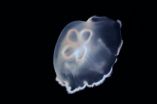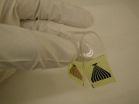(Press-News.org) BLOOMINGTON -- A new Indiana University study that examines the brain activity of alcohol-dependent women compared to women who were not addicted found stark and surprising differences, leading to intriguing questions about brain network functions of addicted women as they make risky decisions about when and what to drink.
The study used functional magnetic resonance imaging, or fMRI, to study differences between patterns of brain network activation in the two groups of women. The findings indicate that the anterior insular region of the brain may be implicated in the process, suggesting a possible new target of treatment for alcohol-dependent women.
"We see that the network dynamics of alcohol-dependent women may be really different from that of healthy controls in a drinking-related task," said Lindsay Arcurio, a graduate student in the Department of Psychological and Brain Sciences. "We have evidence to suggest alcohol-dependent women have trouble switching between networks of the brain."
The research is part of a larger new effort to understand the differences between men and women with respect to alcohol. Arcurio said most of the research on alcohol dependence has been conducted with men or groups of men and women. Yet several factors make looking at women "really important."
One such factor is that the physiological effects of drinking alcohol, which include liver damage, heart disease or breast cancer, set in much earlier in women than in men. For this reason, the suggested limit on the number of drinks per week that women can safely consume is eight, whereas for men, it is 14. Secondly, binge-drinking in women is on the rise. One in five adolescent girls is binge-drinking three times a month. In women between the ages of 18 and 54, that number is one in eight.
A 'sledgehammer' approach to defining differences in brain network activation
Research on decision-making mechanisms in alcohol-dependent individuals typically involves a general risk-taking situation in which money or points are at stake. In this study, participants were placed in the fMRI brain scanner and asked to consider low-risk and high-risk situations specifically related to alcohol -- what the researchers describe as "ecological" tasks. Participants were then asked to make decisions regarding control stimuli -- food as well as a presumably neutral stimuli, a stapler -- to observe whether risky behavior was greater with respect to drinking than with these other items. The same picture cues were used to present high-risk and low-risk scenarios, and these two extremes were as follows:
For the low-risk situation, participants were told: Imagine you are at a bar. You are offered a drink, already paid for, with two shots of alcohol, and you have a safe ride home. For the high-risk, they were told: You are at a bar and are offered a drink already paid for, with six shots of alcohol, but you do not have a safe ride home.
The reason for such an extreme contrast between the two situations, Arcurio said, is that "as one of the first ecological tasks used in the scanner, we wanted to take a sledgehammer approach to really find the differences between cases that are definitely high-risk and those that are definitely low-risk."
The findings, however, reflect an equally sharp contrast in differences between the brain network activation in alcohol-dependent women versus the controls.
For the control group, high-risk decisions to drink led to the deactivation of regions associated with "approach behavior," deciding to take the drink in a risky situation. Conversely, women in the control group activate regions associated with the default mode network, a region traditionally thought to involve resting-state behavior or inactive or relaxed mental state, but which some now speculate plays a role in conceptualizing one's future.
"It gets really interesting," Arcurio said, "comparing this pattern of activation to those in alcohol-dependent women, who behaviorally say they're more likely to take the high-risk drink compared to the controls. They don't deactivate anything. In contrast to the controls, alcohol-dependent women activate all three regions in question. They activate regions associated with reward (which release dopamine). They also activate frontal control regions involved in cognitive control and regions associated with the default mode network, involved in resting-state behavior. They are activating everything."
The investigators infer from these findings that alcohol-dependent women have trouble switching between networks. Being unable to activate one region and deactivate another in response to an alcohol-related situation means they are unable to use one strategy over another.
Furthermore, Arcurio said, "a lot of evidence suggests that switching between networks is influenced by the anterior insular and anterior cingulate regions of the brain, and we did find major differences in the insula between the alcohol-dependent women and controls. We're thinking the issue is pinpointed to that region."
The researchers are now running analyses to test the hypothesis that the insula helps in this process, which could offer new possibilities for intervention, with both behavioral therapy and medication.
The research is part of a whole research program, both planned and in the works, to further explore the questions about risky decision-making in alcohol-dependent women: studies of adolescent drinking, risky sexual behavior in alcohol-dependent women, the interaction of visual networks with decision-making networks, as well as the way music (or auditory networks) interacts with decision-making mechanisms in alcohol-dependent women. In the latter experiment, college-age participants choose a song that they associate with drinking and one with quiet reflection.
"There's a lot of Miley Cyrus in the first category," Arcurio said.
INFORMATION:
The current study, "Neural mechanisms of high-risk decisions-to-drink in alcohol-dependent women," appears in the Dec. 23 issue of Addiction Biology.
Other investigators include professors Thomas James, director of the Perception and Neuroimaging Lab, and Peter Finn, director of the Behavioral Alcohol Research Laboratory, both in the Department of Psychological and Brain Sciences in the College of Arts and Sciences at IU Bloomington.
For more information or to speak with Arcurio, James or Finn, contact Liz Rosdeitcher at rosdeitc@indiana.edu or 812-855-4507 or Tracy James at 812-855-0084 or traljame@iu.edu. The paper was funded by a grant to Professor James from the National Institute on Alcohol Abuse and Alcoholism.
Study uncovers surprising differences in brain activity of alcohol-dependent women
2014-02-18
ELSE PRESS RELEASES FROM THIS DATE:
85 percent of heart attacks after surgery go undetected due to lack of symptoms
2014-02-18
Without administering a simple blood test in the first few days after surgery, 85 percent of the heart attacks or injuries patients suffer could be missed, according to a study in the March issue of Anesthesiology. Globally, more than 8 million adults have heart attacks or injuries after surgery every year, and 10 percent of those patients die within 30 days.
The study suggests a new diagnosis, Myocardial Injury after Noncardiac Surgery (MINS), would be useful to physicians because of its broader definition from what is traditionally used to diagnose heart attacks now. ...
Chance of falling after knee replacement not increased by regional anesthesia
2014-02-18
Two types of regional anesthesia do not make patients more prone to falls in the first days after having knee replacement surgery as some have previously suggested, according to a study based on nearly 200,000 patient records in the March issue of Anesthesiology.
Regional forms of anesthesia – spinal or epidural (neuraxial) anesthesia and peripheral nerve blocks (PNB) – which only numb the area of the body that requires surgery, provide better pain control and faster rehabilitation and fewer complications than general anesthesia, research shows. But some surgeons avoid ...
Obese patients who feel judged by doctors are less likely to shed pounds, study shows
2014-02-18
Overweight and obese people who feel their physicians are judgmental of their size are more likely to try to shed pounds but are less likely to succeed, according to results of a study by Johns Hopkins researchers.
The findings, reported online last week in the journal Preventive Medicine, suggest that primary care doctors should lose the negative attitudes their patients can sense if the goal is to get patients with obesity to lose 10 percent or more of their body weight — an amount typically large enough to reduce blood pressure, cholesterol and diabetes risk.
"Negative ...
Medicaid's 'tube-tying' polices create roadblocks for low-income women
2014-02-18
PRINCETON, N.J.—Tubal ligation – commonly referred to as having one's "tubes tied" – is widely used to prevent unintended pregnancies. However, current Medicaid policies create roadblocks for low-income women trying to obtain the procedure, according to a review written by researchers at Princeton University's Woodrow Wilson School and other U.S. institutions.
Under a Medicaid rule enacted in 1978, women must currently wait 30 days after signing a written consent form to obtain a tubal ligation. This requirement is prohibitive for many women who want to receive the ...
Can marijuana protect the immune system against HIV and slow disease progression?
2014-02-18
New Rochelle, NY, February 18, 2014—New evidence that chronic intake of THC, the primary psychoactive ingredient in marijuana, can protect critical immune tissue in the gut from the damaging effects of HIV infection is reported in AIDS Research and Human Retroviruses, a peer-reviewed journal from Mary Ann Liebert, Inc., publishers. The article is available free on the AIDS Research and Human Retroviruses website at http://www.liebertpub.com/aid.
Patricia Molina and coauthors from Louisiana State University Health Sciences Center, New Orleans, report that chronic THC administration ...
Solar-induced hybrid fuel cell produces electricity directly from biomass
2014-02-18
Although low temperature fuel cells powered by methanol or hydrogen have been well studied, existing low temperature fuel cell technologies cannot directly use biomass as a fuel because of the lack of an effective catalyst system for polymeric materials.
Now, researchers at the Georgia Institute of Technology have developed a new type of low-temperature fuel cell that directly converts biomass to electricity with assistance from a catalyst activated by solar or thermal energy. The hybrid fuel cell can use a wide variety of biomass sources, including starch, cellulose, ...
Quest for jellyfish robot leads to discovery of bending rules for animal wing, fin tips
2014-02-18
WOODS HOLE, Mass. —A Navy-sponsored project to design a biologically inspired, swimming jellyfish robot has led scientists to the surprising discovery of common bending rules for the tips of wings, fins, flukes, mollusk feet, and other propulsors across a broad range of animal species.
The study, led by John H. Costello of Providence College and the Marine Biological Laboratory (MBL) in Woods Hole, where he is a visiting scientist, is published this week in Nature Communications.
By studying videos of 59 different animals—from fruit flies to humpback whales—propelling ...
Single chip device to provide real-time 3-D images from inside the heart, blood vessels
2014-02-18
Researchers have developed the technology for a catheter-based device that would provide forward-looking, real-time, three-dimensional imaging from inside the heart, coronary arteries and peripheral blood vessels. With its volumetric imaging, the new device could better guide surgeons working in the heart, and potentially allow more of patients' clogged arteries to be cleared without major surgery.
The device integrates ultrasound transducers with processing electronics on a single 1.4 millimeter silicon chip. On-chip processing of signals allows data from more than a ...
'Legal highs,' PMMA and zombie panic
2014-02-18
Recent deaths in both Canada and the UK linked to PMA/PMMA in ecstasy pills has brought public scrutiny to this little known drug. With Canadian producing most of the ecstasy in the North American market, this timely paper (Ecstasy, legal highs and designer drug use: A Canadian perspective) published this week in Drug Science Policy and Law looks at trends in ecstasy adulteration, the facts around PMA/PMMA-linked deaths and explores alternatives to the endless banning of new drugs.
It finds:
In 2007, according to the Health Canada Drug Analysis Service, only 3% of seized ...
A stretchable highway for light
2014-02-18
WASHINGTON, Feb. 18, 2014—For futuristic applications like wearable body sensors and robotic skin, researchers need to ferry information along flexible routes. Electronics that bend and stretch have become possible in recent years, but similar work in the field of optics – communicating with light instead of electrons – has lagged behind. Particularly difficult to engineer have been optics that stretch, lengthening when someone wearing body sensors bends to tie their shoe, or when a robotic arm twists through a full range of motion.
Now a team of Belgian researchers reports ...







